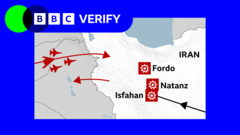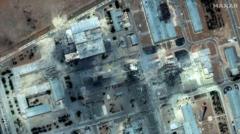The Pentagon outlines 'Operation Midnight Hammer' that targeted Iran's critical nuclear facilities through strategic deception and high-tech warfare.
**US Executes Complex Airstrike on Iran's Nuclear Sites Amidst Stealth and Deception**

**US Executes Complex Airstrike on Iran's Nuclear Sites Amidst Stealth and Deception**
A detailed look into the operation reveals a remarkable display of military coordination and strategy.
The operation, dubbed ‘Operation Midnight Hammer,’ commenced under the veil of night as a stealthy fleet of B-2 bombers departed from Whiteman Air Force Base in Missouri. US Secretary of Defense Pete Hegseth, along with top officials including President Donald Trump and Vice-President JD Vance, observed the departure from the Situation Room, completely unaware that attention was being subtly diverted to decoy flights over the Pacific.
General Dan Caine, the Chairman of the Joint Chiefs of Staff, reported that the actual mission was conducted with utmost secrecy, involving extensive mid-air refuelings and deception strategies designed to mislead any potential observers. The true aim was to strike Iran's fortified nuclear sites, particularly the notorious Fordo facility, buried deep within a mountain, making it a significant target for the US’s powerful ‘bunker buster’ bombs.
As thousands of eyes were mistakenly drawn toward aircraft movements in Guam, the real mission was underway, flying undetected over the Atlantic. The seven B-2 bombers, equipped with state-of-the-art munitions, navigated with limited communication to avoid detection.
Upon entry into the Middle East, the bombers were supported by additional aircraft that screened for threats, which, according to US officials, were notably absent as Iranian air defenses remained idle. Analysts attribute this to Israel's established aerial dominance, allowing the American forces to execute their targets with minimal resistance.
At approximately 17:00 EDT, more than two dozen Tomahawk cruise missiles were launched from a US submarine, synchronizing with the B-2 bombers attacking the Fordo and Natanz sites. The advanced precision of this multi-site operation marked a historic use of bunker buster weapons in actual combat scenarios, culminating in a swift strike where around 75 high-precision munitions were deployed over approximately 25 minutes.
While the US government declared the strikes a monumental victory, the full ramifications of this operation remain uncertain. Iran's response was to acknowledge the attacks while downplaying the extent of the destruction. Experts argue that while tactically successful, the long-term impact on Iran's nuclear aspirations remains unclear, with further assessments needed to determine the effectiveness of the strikes against the ground structures of its nuclear facilities.
This meticulously orchestrated military operation underscores the evolving tactics in modern warfare, integrating decoy strategies with advanced munitions in a high-stakes geopolitical landscape.
General Dan Caine, the Chairman of the Joint Chiefs of Staff, reported that the actual mission was conducted with utmost secrecy, involving extensive mid-air refuelings and deception strategies designed to mislead any potential observers. The true aim was to strike Iran's fortified nuclear sites, particularly the notorious Fordo facility, buried deep within a mountain, making it a significant target for the US’s powerful ‘bunker buster’ bombs.
As thousands of eyes were mistakenly drawn toward aircraft movements in Guam, the real mission was underway, flying undetected over the Atlantic. The seven B-2 bombers, equipped with state-of-the-art munitions, navigated with limited communication to avoid detection.
Upon entry into the Middle East, the bombers were supported by additional aircraft that screened for threats, which, according to US officials, were notably absent as Iranian air defenses remained idle. Analysts attribute this to Israel's established aerial dominance, allowing the American forces to execute their targets with minimal resistance.
At approximately 17:00 EDT, more than two dozen Tomahawk cruise missiles were launched from a US submarine, synchronizing with the B-2 bombers attacking the Fordo and Natanz sites. The advanced precision of this multi-site operation marked a historic use of bunker buster weapons in actual combat scenarios, culminating in a swift strike where around 75 high-precision munitions were deployed over approximately 25 minutes.
While the US government declared the strikes a monumental victory, the full ramifications of this operation remain uncertain. Iran's response was to acknowledge the attacks while downplaying the extent of the destruction. Experts argue that while tactically successful, the long-term impact on Iran's nuclear aspirations remains unclear, with further assessments needed to determine the effectiveness of the strikes against the ground structures of its nuclear facilities.
This meticulously orchestrated military operation underscores the evolving tactics in modern warfare, integrating decoy strategies with advanced munitions in a high-stakes geopolitical landscape.





















